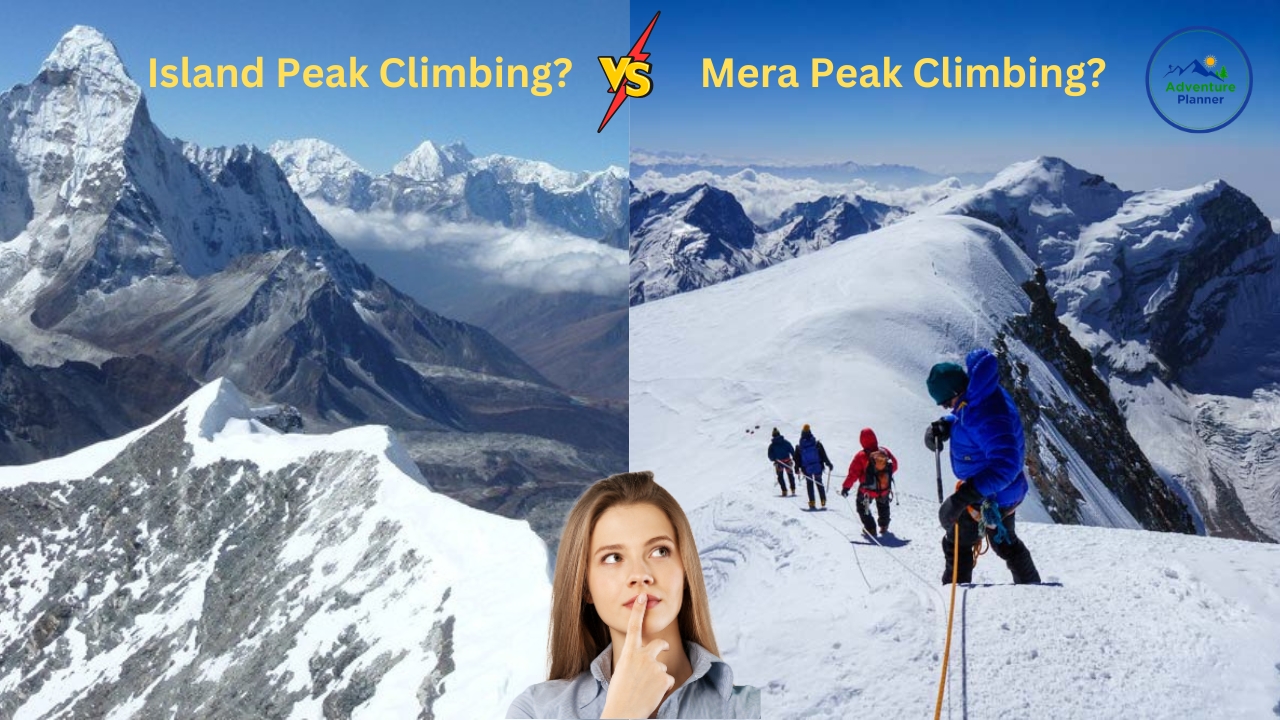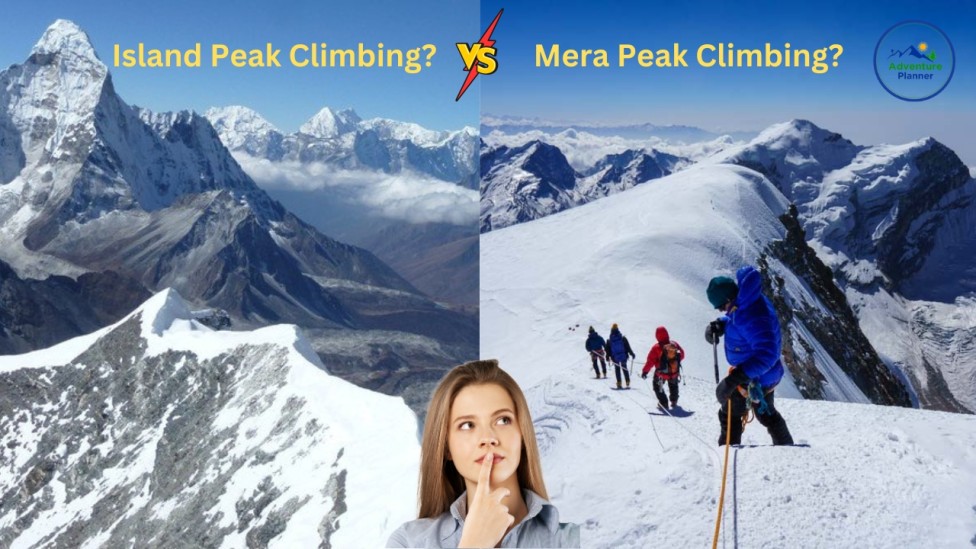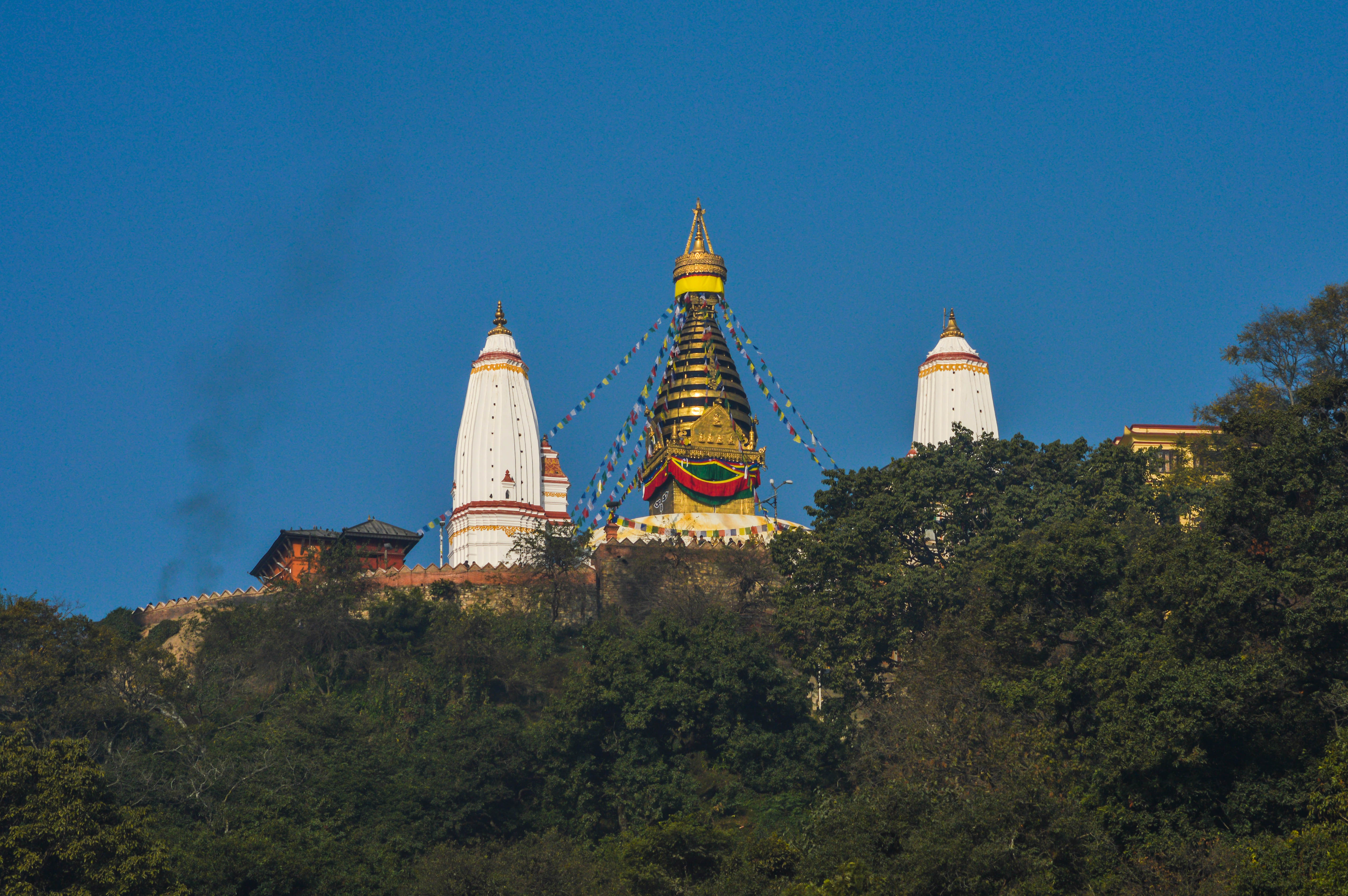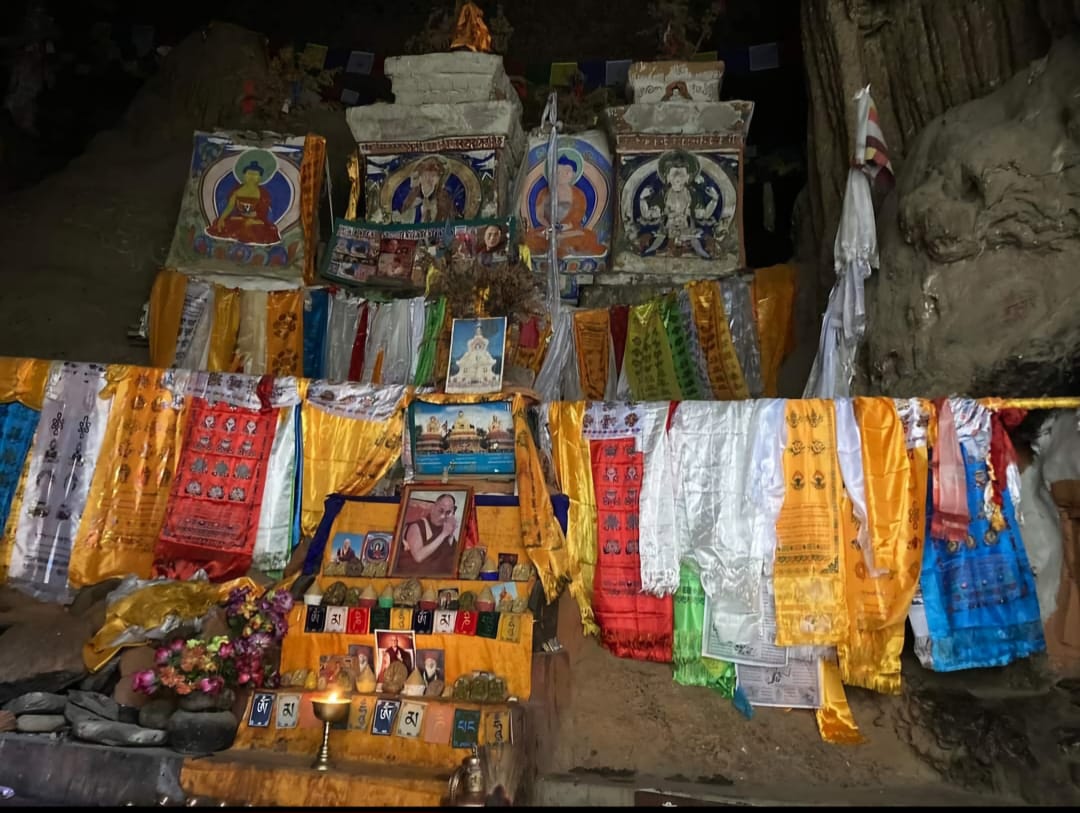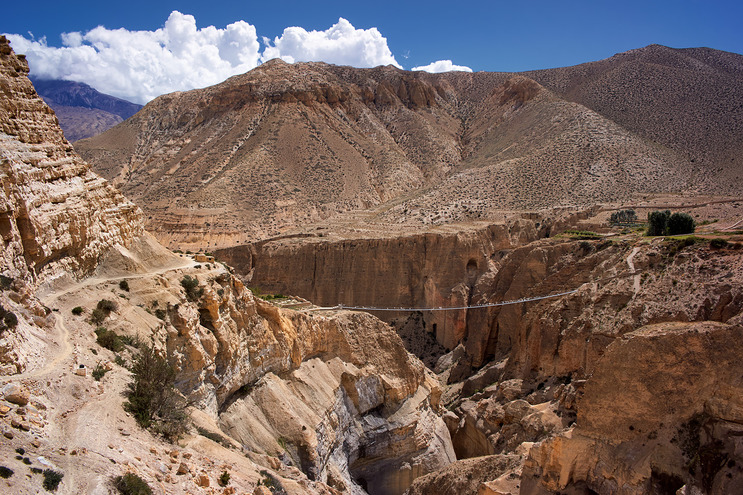Mera Peak and Island Peak are both popular trekking peaks in Nepal, but they have distinct differences. Here’s a breakdown of their main contrasts:
1. Elevation
- Mera Peak: 6,476 meters (21,247 feet)
- Island Peak: 6,189 meters (20,305 feet)
Mera Peak is higher than Island Peak, which means it might be a bit more challenging, especially in terms of altitude and acclimatization.
2. Location
- Mera Peak: Located in the Khumbu region, southeast of Mount Everest. It's more remote compared to Island Peak, requiring a longer trek to reach the base camp.
- Island Peak: Situated in the Imja Valley, part of the Khumbu region, near the Everest Base Camp trekking route.
Island Peak is often combined with an Everest Base Camp trek, while Mera Peak is typically reached through the Hinku Valley, a less-traveled route.
3. Climbing Difficulty Compare Mera and Island Peak
When comparing the climbing difficulty of Mera Peak and Island Peak, both are considered trekking peaks, but they differ in their technical challenges and overall demands. Here's a breakdown of the factors that contribute to their difficulty:
1. Technical Difficulty
Island Peak:
- Moderate to High: The final section of the climb is steeper, requiring technical mountaineering skills. You’ll need to use crampons, an ice axe, and rope skills to navigate the summit ridge, which has a steep, snowy/icy face.
- Key Challenge: The summit push involves a fixed rope section, which requires climbing up a steep, narrow ridge. While this can be managed by most trekkers with some experience, it adds a significant technical component compared to Mera Peak.
- Technical Gear: You'll be required to have a solid knowledge of how to use technical gear, especially in glacier conditions.
Mera Peak:
- Moderate: Mera Peak, on the other hand, is considered less technical but still requires some basic mountaineering skills, such as glacier travel, the use of crampons, and basic rope handling. The climb is mainly glacier-based, with the final summit push being a bit steep but not requiring the same level of technical climbing as Island Peak.
- Key Challenge: The difficulty lies more in the altitude and the glacier sections, with crevasses being a concern. While the route itself is not overly steep, the altitude at the higher camp (around 6,000 meters) requires careful acclimatization.
- Technical Gear: Although basic technical gear is still needed, climbing experience in glacier environments is a big plus.
2. Altitude
Island Peak:
- Elevation: 6,189 meters (20,305 feet).
- While the summit is lower than Mera Peak, altitude is still a major factor here, and it can affect anyone, especially when climbing in the Everest region.
- Acclimatization should be taken seriously to avoid altitude sickness.
Mera Peak:
- Elevation: 6,476 meters (21,247 feet).
- The higher elevation makes the climb more altitude-dependent. At Mera Peak's summit, you're pushing above 6,000 meters, which is considered high-altitude climbing, making it harder to acclimatize and increasing the risk of altitude sickness.
- While the technical difficulty is lower, altitude becomes a bigger factor in your overall success.
3. Physical Endurance
Island Peak:
- The technical sections on Island Peak require more physical strength as you climb steeper, icy sections. The climb is shorter in duration but can be physically demanding on the final push.
- The ascent time is shorter than Mera Peak, but the summit day can still be intense, lasting long hours, especially with the technical climb involved.
Mera Peak:
- The trek to Mera Peak base camp is longer, and the climb itself takes a longer time compared to Island Peak. This means the physical endurance required is higher in terms of days of trekking and altitude management.
- The summit push is less steep but still requires stamina to climb up the final section, often in snow conditions.
4. Overall Climb Difficulty Compare Island and Mera Peak Climbing
Island Peak:
- Technical Climbing + Moderate Altitude: The challenge is mainly in the technical aspect (steep sections and fixed ropes), requiring a climber to have technical mountaineering skills, but the altitude isn’t as extreme as Mera Peak.
- It’s considered a more challenging technical climb for trekkers looking to try more technical mountaineering.
Mera Peak:
- Higher Altitude + Less Technical: The difficulty lies more in the altitude and the length of the climb. The technical aspects are not as demanding, but reaching 6,476 meters requires extra acclimatization and endurance, as well as dealing with glacier conditions.
Mera Peak and Island Peak Climbing Compare Summary Comparison
Factor | Island Peak | Mera Peak |
|---|---|---|
Elevation | 6,189 meters (20,305 feet) | 6,476 meters (21,247 feet) |
Technical Difficulty | High (Steep, technical summit push) | Moderate (Glacier, but not as steep) |
Altitude Difficulty | Moderate (Altitude sickness possible) | High (Requires careful acclimatization) |
Climb Duration | Shorter, but intense summit push | Longer trek, requires more days for acclimatization |
Required Skills | Ice axe, crampons, and rope use required | Basic mountaineering skills for glacier travel |
Physical Demand | Moderate, more technical effort on summit | High endurance due to longer trek and higher altitude |
- If you prefer a more technical climb with a slightly lower altitude and are comfortable with steep ice and rock sections, Island Peak is your choice.
- If you prioritize a higher summit, are more comfortable with glacier climbing, and have previous altitude experience, Mera Peak is a good option, though it comes with the challenge of greater altitude.
It’s not just about the climb itself but also about how you manage altitude and technical skills. If you're more experienced with mountaineering gear and enjoy a technical challenge, Island Peak might be the better option. If you’re comfortable with a longer trek and don’t mind a less technical climb at a higher elevation, Mera Peak could be your pick.
4. Climbing Route Compare Mera and Island Peak
- Mera Peak: The climb is less technical compared to Island Peak. There’s a glacier to traverse, and climbers need to be prepared for snow and ice conditions, but it’s mostly a straightforward summit with some steeper sections near the top.
- Island Peak: Has more challenging and steeper sections, particularly near the summit, where climbers face a final ridge and ice wall.
5. Duration of the Trek
- Mera Peak: The trek to Mera Peak base camp is longer, often taking 2-3 weeks. It’s a more remote expedition that allows for better acclimatization.
- Island Peak: The trek to Island Peak typically takes 1-2 weeks, especially if combined with the Everest Base Camp trek. It’s quicker but still requires a few days for acclimatization.
6. Trekking Experience
- Mera Peak: The approach to Mera Peak is through more remote, less-trafficked areas of Nepal, offering a quieter, more serene experience.
- Island Peak: Being closer to the Everest Base Camp route, Island Peak tends to have more trekkers and climbers around, especially during peak trekking seasons.
7. Popularity
- Mera Peak: Considered one of the highest trekking peaks in Nepal, it’s less popular compared to Island Peak, which may appeal to those seeking more solitude.
- Island Peak: More popular due to its accessibility from the Everest Base Camp trek, often seen as a "gateway" peak for those looking to attempt larger mountains in the Himalayas, like Ama Dablam or Everest itself.
8. Summit Views
- Mera Peak: Offers incredible views of the entire Khumbu region, including Everest, Makalu, and Lhotse.
- Island Peak: Provides stunning views of Everest, Lhotse, and Nuptse, but it’s a bit more limited in its panoramic view compared to Mera Peak.
Mera Peak is suited for climbers seeking a more remote and challenging expedition with higher altitude and less foot traffic.
Island Peak is great for climbers who want to challenge themselves with a technical climb while having the convenience of the Everest Base Camp trek.
Have Previous Altitude Experience Peak Climbing in Nepal?
If you Have Previous Altitude Experience in Peak Climbing in Nepal, you're in a better position to tackle either Mera Peak or Island Peak, but there are still some considerations based on your experience level. Here’s how having prior altitude experience can help you:
1. Mera Peak Climbing
- Elevation: 6,476 meters (21,247 feet)
- If you have experience climbing at altitudes above 5,000 meters (16,404 feet) or have been to higher peaks, you'll have an advantage in acclimatizing to Mera Peak’s altitude.
- Having a solid understanding of how your body reacts to high altitudes will help manage risks like altitude sickness.
- The higher elevation of Mera Peak may require more careful planning, especially for acclimatization. Since it’s at a higher altitude than Island Peak, even experienced trekkers and climbers need to be cautious and follow a gradual ascent plan to allow for proper acclimatization.
2. Island Peak Climbing
- Elevation: 6,189 meters (20,305 feet)
- If your previous altitude experience includes climbing peaks between 5,000 and 6,000 meters (16,404 - 19,685 feet), Island Peak might feel more manageable.
- The technical nature of the climb may be more of a challenge, but if you’ve already used crampons and an ice axe in high-altitude settings, you’ll be better prepared for the final sections of the summit push.
Key Considerations with Previous Altitude Experience:
- Acclimatization: Even if you're experienced at high altitudes, remember that every climb is different. Both peaks will still require careful attention to acclimatization to prevent altitude sickness.
- Physical Fitness: Previous altitude experience will give you an understanding of what physical demands to expect. However, being in top physical shape is still crucial for successfully summiting.
- Mental Preparation: With experience, you'll know the importance of pacing yourself, staying hydrated, and keeping a positive mental attitude at high altitudes.
- Mera Peak may feel like a bigger challenge in terms of altitude, but if you've handled similar altitudes, you'll be able to tackle it with good preparation.
- Island Peak has a more technical climb, but at a slightly lower altitude. If you've done technical climbing before at these elevations, it might be more enjoyable.
Both peaks are achievable with prior altitude experience, but make sure to assess your skills in high-altitude conditions, your ability to use mountaineering gear, and your personal health for optimal performance.
Pick Island Peak Vs Mera Peak, Which is Good?
Choosing between Island Peak and Mera Peak depends on a few factors like your climbing goals, experience, and what kind of adventure you’re seeking. Here are a few things to consider that might help you make your decision:
Go for Island Peak if you:
- Want a technical challenge: Island Peak is known for its steep final summit push, which requires use of crampons, ice axes, and rope skills. If you're looking for more technical climbing experience, this would be a great choice.
- Are aiming for a quicker trek: The Island Peak trek is shorter compared to Mera Peak, especially if you're combining it with an Everest Base Camp trek. It offers a chance to experience the Himalayas with less time commitment.
- Are comfortable with higher traffic: Being close to the Everest Base Camp route means more trekkers and climbers, which can be a plus if you enjoy the camaraderie, or it might be something to consider if you prefer a quieter experience.
Go for Mera Peak if you:
- Want a higher, more remote peak: Mera Peak is higher and more isolated than Island Peak. If you're looking for solitude and a sense of adventure in a more remote area, this will offer a quieter, more scenic experience.
- Have experience at high altitudes: Mera Peak is a bit higher and may take more time to acclimatize to, so if you have previous altitude experience, you’ll have an easier time managing that. The climb is also less technical but involves some glacier travel and steep sections.
- Prefer a longer trek with fewer crowds: Mera Peak offers a more immersive trek in the Khumbu region. If you like the idea of a longer trek with stunning panoramic views and fewer people around, Mera Peak could be ideal.
Conclusion Summary Mera Peak vs Island Peak Climbing
Both Mera Peak and Island Peak offer unique climbing experiences in the stunning Himalayas of Nepal, and choosing between the two will depend on your adventure goals, climbing experience, and the kind of challenge you're seeking.
- Island Peak: More technical climbing, shorter trek, and often combined with the Everest Base Camp route. If you're looking to challenge yourself technically, but still want a "classic" Himalayan climb, this could be the one.
- Mera Peak: Higher altitude, less technical, and more remote. If you're drawn to a higher, quieter peak with stunning views and don’t mind the extra time spent trekking to the base camp, Mera Peak might be more suitable.
In short, Mera Peak is best for climbers who are ready for a more remote, high-altitude trek, and Island Peak is suited for those who want to experience a more technical climb in a shorter timeframe. Both are incredible options, and working with adventure planners will help you tailor the trip to your specific goals, providing guides, equipment, and support based on your experience level and preferences.
